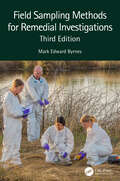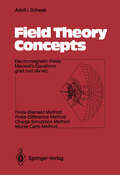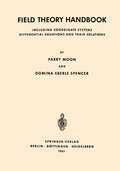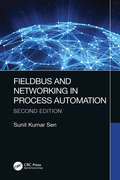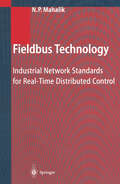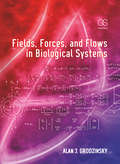- Table View
- List View
Field Sampling Methods for Remedial Investigations
by Mark Edward ByrnesOriginally published in 1994, the first edition of Field Sampling Methods for Remedial Investigations soon became a premier resource in this field. The "Princeton Groundwater" course designated it as one of the top books on the market that addresses strategies for groundwater characterization, groundwater well installation, well completion, and groundwater sampling. This long awaited third edition provides most current and most cost-effective environmental media characterization methods and approaches supporting all aspects of remediation activities. This book integrates recommendations from over one hundred of the most current US EPA, State EPA, US Geological Survey, US Army Corps of Engineers, and National Laboratory environmental guidance and/or technical documents. This book provides guidance, examples, and/or case studies for the following subjects: Implementing the EPA’s latest Data Quality Objectives process Developing cost effective statistical & non-statistical sampling designs supporting all aspects of environmental remediation activities, and available statistical sample design software Aerial photography, surface geophysics, airborne/surface/downhole/building radiological surveys, soil gas surveying, environmental media sampling, DNAPL screening, portable X-ray fluorescence measurements Direct push groundwater sampling, well installation, well development, well purging, no-purge/low-flow/standard groundwater sampling, depth-discrete ground sampling, groundwater modeling Tracer testing, slug testing, waste container and building material sampling, pipe surveying, defining background conditions Documentation, quality control sampling, data verification/validation, data quality assessment, decontamination, health & safety, management of investigation waste A recognized expert on this subject, author Mark Byrnes provides standard operating procedures and guidance on the proper implementation of these methods, focusing on proven technologies that are acknowledged by EPA and State regulatory agencies as reputable techniques.
Field-Scale Water and Solute Flux in Soils (Monte Verita)
by Roth Flühler JuryThis book contains the proceedings of the first workshop held at Monte Verità near Ascona, Switzerland on September 24-29, 1989. The workshop was designed to survey the current understanding of water and solute transport through unsaturated soils under field conditions, and to foster research by discussing some unresolved key issues relative to transport modeling and experimentation in four "Think Tank" groups. The first part of this book consists of the reports prepared by the Think Tank groups, who discussed the following topics: modeling approaches, effective large scale properties, evaluation of filed properties, and the role preferential flow. The second part contains a selection of reviewed original contributions presented at the workshop, with topics ranging from the presentation of results from large scale experiments, to improved or new modeling approaches, and to legal or policy aspects. This book is intended for researchers in soil science, hydrology, and environmental engineering who have an interest in transport and reaction processes in the unsaturated zone. It will provide them with a representative sample of current research activities, and with a group discussion of future research directions in four important areas of water and solute transport.
Field Screening Europe 2001: Proceedings of the Second International Conference on Strategies and Techniques for the Investigation and Monitoring of Contaminated Sites
by Wolfgang Breh Johannes Gottlieb Heinz Hötzl Frieder Kern Tanja Liesch Reinhard Niessner"Field screening" indicates field analytical tools, and (quick) methods and strategies for on-site or in-situ environmental analysis and assessment of contamination. "Field screening" includes not only field analytical methods, such as mobile laboratories, portable analyses, detectors, sensors, or noninvasive techniques, but also reconnaissance strategies and problems of measurement in heterogeneous media, using, among others, new geotechnical and geophysical instruments. This volume contains both oral and poster contributions to the Second International Conference on Strategies and Techniques for the Investigation and Monitoring of Contaminated Sites, "Field Screening Europe 2001", held in Karlsruhe, May 14 - May 16, 2001. As an integrated study of environmental contamination, "field screening" has become a more and more important part of environmental monitoring and the assessment of chemical contaminations. Recent developments are presented in these proceedings. Audience: Environmental engineers, geo-scientists, chemists, biologists, soil scientists, hydrologists and geophysicists.
Field Solutions on Computers
by Stanley Humphries Jr.Field Solutions on Computers covers a broad range of practical applications involving electric and magnetic fields. The text emphasizes finite-element techniques to solve real-world problems in research and industry. After introducing numerical methods with a thorough treatment of electrostatics, the book moves in a structured sequence to advanced topics. These include magnetostatics with non-linear materials, permanent magnet devices, RF heating, eddy current analysis, electromagnetic pulses, microwave structures, and wave scattering. The mathematical derivations are supplemented with chapter exercises and comprehensive reviews of the underlying physics. The book also covers essential supporting techniques such as mesh generation, interpolation, sparse matrix inversions, and advanced plotting routines.
Field Solutions on Computers
by Stanley Humphries Jr.Field Solutions on Computers covers a broad range of practical applications involving electric and magnetic fields. The text emphasizes finite-element techniques to solve real-world problems in research and industry. After introducing numerical methods with a thorough treatment of electrostatics, the book moves in a structured sequence to advanced topics. These include magnetostatics with non-linear materials, permanent magnet devices, RF heating, eddy current analysis, electromagnetic pulses, microwave structures, and wave scattering. The mathematical derivations are supplemented with chapter exercises and comprehensive reviews of the underlying physics. The book also covers essential supporting techniques such as mesh generation, interpolation, sparse matrix inversions, and advanced plotting routines.
Field Theoretic Method in Phase Transformations (Lecture Notes in Physics #840)
by Alexander UmantsevThe main subject of the book is the continuum, field theoretic method of study of phase transformations in material systems. The method, also known as "phase field", allows one to analyze different stages of transformations on the unified platform. It has received significant attention in the materials science community recently due to many successes in solving or illuminating important problems. The book will address fundamentals of the method starting from the classical theories of phase transitions, the most important theoretical and computational results, and some of the most advanced recent applications.
Field Theoretic Method in Phase Transformations (Lecture Notes in Physics #1016)
by Alexander UmantsevThis book describes a novel and popular method for the theoretical and computational study of phase transformations and materials processing in condensed and soft matter. The field theoretic method for the study of phase transformations in material systems, also known as the phase-field method, allows one to analyze different stages of transformations within a unified framework. It has received significant attention in the materials science community due to many recent successes in solving or illuminating important problems. In a single volume, this book addresses the fundamentals of the method starting from the basics of the field theoretic method along with its most important theoretical and computational results and some of the most advanced recent results and applications. Now in a revised and expanded second edition, the text is updated throughout and includes material on the classical theory of phase transformations. This book serves as both a primer in the area of phase transformations for those new to the field and as a guide for the more seasoned researcher. It is also of interest to historians of physics.
Field Theory Concepts: Electromagnetic Fields. Maxwell’s Equations grad, curl, div. etc. Finite-Element Method. Finite-Difference Method. Charge Simulation Method. Monte Carlo Method
by Adolf J. Schwab"Field Theory Concepts" is a new approach to the teaching and understanding of field theory. Exploiting formal analo- gies of electric, magnetic, and conduction fields and introducing generic concepts results in a transparently structured electomagnetic field theory. Highly illustrative terms alloweasyaccess to the concepts of curl and div which generally are conceptually demanding. Emphasis is placed on the static, quasistatic and dynamic nature of fields. Eventually, numerical field calculation algorithms, e.g. Finite Element method and Monte Carlo method, are presented in a concise yet illustrative manner.
Field Theory Handbook: Including Coordinate Systems, Differential Equations and Their Solutions
by Parry Moon Domina E. SpencerLet us first state exactly what this book is and what it is not. It is a compendium of equations for the physicist and the engineer working with electrostatics, magne tostatics, electric currents, electromagnetic fields, heat flow, gravitation, diffusion, optics, or acoustics. It tabulates the properties of 40 coordinate systems, states the Laplace and Helmholtz equations in each coordinate system, and gives the separation equations and their solutions. But it is not a textbook and it does not cover relativistic and quantum phenomena. The history of classical physics may be regarded as an interplay between two ideas, the concept of action-at-a-distance and the concept of a field. Newton's equation of universal gravitation, for instance, implies action-at-a-distance. The same form of equation was employed by COULOMB to express the force between charged particles. AMPERE and GAUSS extended this idea to the phenomenological action between currents. In 1867, LUDVIG LORENZ formulated electrodynamics as retarded action-at-a-distance. At almost the same time, MAXWELL presented the alternative formulation in terms of fields. In most cases, the field approach has shown itself to be the more powerful.
Field Theory of Nonimaging Optics
by Angel Garcia-Botella Roland Winston Lun JiangThis book aims to overcome the traditional ray paradigm and provide an analytical paradigm for Nonimaging Optics based on Field Theory. As a second objective, the authors address the connections between this Field Theory of Nonimaging Optics and other radiative transfer theories. The book introduces the Field Theory of Nonimaging Optics as a new analytical paradigm, not statistical, to analyze problems in the frame of nonimaging geometrical optics, with a formulation based on field theory of irradiance vector D. This new paradigm provides new principles and tools in the optical system design methods, complementary to flowline method, overcoming the classical ray paradigm. This new Field paradigm can be considered as a generalization of the ray paradigm and new accurate and faster computation algorithms will be developed. In a parallel way, the advance in the knowledge of the principles of Field Theory of Nonimaging Optics has produced clear advances in the connection between nonimaging optics and other apparently disconnected theories of radiation transfer. The irradiance vector D can be considered as the macroscopic average of Poynting vector, with a clear connection with radiation pressure. Lorentz geometry techniques can also be applied to study irradiance vector D. There are clear thermodynamic connections between the nonimaging concentrator and Stefan-Boltzmann law of radiation. From this thermodynamic connection, nonimaging optics and irradiance vector D can also be studied from a phase space point of view. This book is intended for researchers, graduate students, academics and professionals looking to analyze, design and optimize optical systems.
Field Theory of Nonimaging Optics
by Angel Garcia-Botella Roland Winston Lun JiangThis book aims to overcome the traditional ray paradigm and provide an analytical paradigm for Nonimaging Optics based on Field Theory. As a second objective, the authors address the connections between this Field Theory of Nonimaging Optics and other radiative transfer theories. The book introduces the Field Theory of Nonimaging Optics as a new analytical paradigm, not statistical, to analyze problems in the frame of nonimaging geometrical optics, with a formulation based on field theory of irradiance vector D. This new paradigm provides new principles and tools in the optical system design methods, complementary to flowline method, overcoming the classical ray paradigm. This new Field paradigm can be considered as a generalization of the ray paradigm and new accurate and faster computation algorithms will be developed. In a parallel way, the advance in the knowledge of the principles of Field Theory of Nonimaging Optics has produced clear advances in the connection between nonimaging optics and other apparently disconnected theories of radiation transfer. The irradiance vector D can be considered as the macroscopic average of Poynting vector, with a clear connection with radiation pressure. Lorentz geometry techniques can also be applied to study irradiance vector D. There are clear thermodynamic connections between the nonimaging concentrator and Stefan-Boltzmann law of radiation. From this thermodynamic connection, nonimaging optics and irradiance vector D can also be studied from a phase space point of view. This book is intended for researchers, graduate students, academics and professionals looking to analyze, design and optimize optical systems.
Field to Palette: Dialogues on Soil and Art in the Anthropocene
by Alexandra Toland Jay Stratton Noller Gerd WessolekField to Palette: Dialogues on Soil and Art in the Anthropocene is an investigation of the cultural meanings, representations, and values of soil in a time of planetary change. The book offers critical reflections on some of the most challenging environmental problems of our time, including land take, groundwater pollution, desertification, and biodiversity loss. At the same time, the book celebrates diverse forms of resilience in the face of such challenges, beginning with its title as a way of honoring locally controlled food production methods championed by "field to plate" movements worldwide. By focusing on concepts of soil functionality, the book weaves together different disciplinary perspectives in a collection of dialogue texts between artists and scientists, interviews by the editors and invited curators, essays and poems by earth scientists and humanities scholars, soil recipes, maps, and DIY experiments. With contributions from over 100 internationally renowned researchers and practitioners, Field to Palette presents a set of visual methodologies and worldviews that expand our understanding of soil and encourage readers to develop their own interpretations of the ground beneath our feet.
Field to Palette: Dialogues on Soil and Art in the Anthropocene
by Alexandra Toland Jay Stratton Noller Gerd WessolekField to Palette: Dialogues on Soil and Art in the Anthropocene is an investigation of the cultural meanings, representations, and values of soil in a time of planetary change. The book offers critical reflections on some of the most challenging environmental problems of our time, including land take, groundwater pollution, desertification, and biodiversity loss. At the same time, the book celebrates diverse forms of resilience in the face of such challenges, beginning with its title as a way of honoring locally controlled food production methods championed by "field to plate" movements worldwide. By focusing on concepts of soil functionality, the book weaves together different disciplinary perspectives in a collection of dialogue texts between artists and scientists, interviews by the editors and invited curators, essays and poems by earth scientists and humanities scholars, soil recipes, maps, and DIY experiments. With contributions from over 100 internationally renowned researchers and practitioners, Field to Palette presents a set of visual methodologies and worldviews that expand our understanding of soil and encourage readers to develop their own interpretations of the ground beneath our feet.
Fieldbus and Networking in Process Automation
by Sunit Kumar SenFieldbuses, particularly wireless fieldbuses, offer a multitude of benefits to process control and automation. Fieldbuses replace point-to-point technology with digital communication networks, offering increased data availability and easier configurability and interoperability. Fieldbus and Networking in Process Automation discusses the newest fieldbuses on the market today, detailing their utilities, components and configurations, wiring and installation methods, commissioning, and safety aspects under hostile environmental conditions. This clear and concise text: Considers the advantages and shortcomings of the most sought after fieldbuses, including HART, Foundation Fieldbus, and Profibus Presents an overview of data communication, networking, cabling, surge protection systems, and device connection techniques Provides comprehensive coverage of intrinsic safety essential to the process control, automation, and chemical industries Describes different wireless standards and their coexistence issues, as well as wireless sensor networks Examines the latest offerings in the wireless networking arena, such as WHART and ISA100.11a Offering a snapshot of the current state of the art, Fieldbus and Networking in Process Automation not only addresses aspects of integration, interoperability, operation, and automation pertaining to fieldbuses, but also encourages readers to explore potential applications in any given industrial environment.
Fieldbus and Networking in Process Automation
by Sunit Kumar SenFieldbuses, particularly wireless fieldbuses, offer a multitude of benefits to process control and automation. Fieldbuses replace point-to-point technology with digital communication networks, offering increased data availability and easier configurability and interoperability. Fieldbus and Networking in Process Automation discusses the newest fieldbuses on the market today, detailing their utilities, components and configurations, wiring and installation methods, commissioning, and safety aspects under hostile environmental conditions. This clear and concise text: Considers the advantages and shortcomings of the most sought after fieldbuses, including HART, Foundation Fieldbus, and Profibus Presents an overview of data communication, networking, cabling, surge protection systems, and device connection techniques Provides comprehensive coverage of intrinsic safety essential to the process control, automation, and chemical industries Describes different wireless standards and their coexistence issues, as well as wireless sensor networks Examines the latest offerings in the wireless networking arena, such as WHART and ISA100.11a Offering a snapshot of the current state of the art, Fieldbus and Networking in Process Automation not only addresses aspects of integration, interoperability, operation, and automation pertaining to fieldbuses, but also encourages readers to explore potential applications in any given industrial environment.
Fieldbus and Networking in Process Automation
by Sunit Kumar SenOver the last two decades, fieldbus has totally revolutionized the way communication takes place in the fields of process control, automation, and manufacturing industries. Recent introduction of real-time fieldbuses has opened up its application in multi-axis motor control and other time-critical applications. Fieldbus is designed to ensure easy interoperability, smarter network designs, increased data availability, and lessened stress on the design aspects of safety protocols. This second edition of Fieldbus and Networking in Process Automation discusses the different facets of fieldbus technology including design, wiring, installation, and commissioning as well as safety aspects in hostile application areas. The book: • Explains basic communication principles and networking—a must for understanding fieldbuses • Considers the advantages and shortcomings of individual fieldbuses • Provides a broad spectrum of different fieldbuses used in both process control and manufacturing industries in a precise and to-the-point manner • Introduces Common Industrial Protocol (CIP), EtherNet/IP, EtherCAT, SERCOS III, Powerlink, and Profinet IRT, which are mostly sought after in control and automation fields • Discusses hard real-time communication in a succinct manner—so essential in today’s multi-axis motor control systems • Updates and streamlines the extra details from the original book to make it more concise and reader friendly Sunit Kumar Sen, a member of IET, holds advanced degrees from St Xavier’s College and University of Calcutta, both in Kolkata, India. He was an ex-professor in the Instrumentation Engineering section of the Department of Applied Physics, University of Calcutta, and taught courses in digital electronics, communication, industrial instrumentation, microprocessors, electrical networks, and fieldbuses. He was the head of the Department of Applied Physics and University Science Instrumentation Center from 2008-2010 at the University of Calcutta. Previously, he was assistant manager, instrumentation (oprn.) at the Bokaro Steel Plant, Jharkhand, India, under the Steel Authority of India (SAIL). He has already written four books in the areas of instrumentation, microprocessors, and industrial automation technologies. He has been published in approximately 70 national and international journals and conferences.
Fieldbus and Networking in Process Automation
by Sunit Kumar SenOver the last two decades, fieldbus has totally revolutionized the way communication takes place in the fields of process control, automation, and manufacturing industries. Recent introduction of real-time fieldbuses has opened up its application in multi-axis motor control and other time-critical applications. Fieldbus is designed to ensure easy interoperability, smarter network designs, increased data availability, and lessened stress on the design aspects of safety protocols. This second edition of Fieldbus and Networking in Process Automation discusses the different facets of fieldbus technology including design, wiring, installation, and commissioning as well as safety aspects in hostile application areas. The book: • Explains basic communication principles and networking—a must for understanding fieldbuses • Considers the advantages and shortcomings of individual fieldbuses • Provides a broad spectrum of different fieldbuses used in both process control and manufacturing industries in a precise and to-the-point manner • Introduces Common Industrial Protocol (CIP), EtherNet/IP, EtherCAT, SERCOS III, Powerlink, and Profinet IRT, which are mostly sought after in control and automation fields • Discusses hard real-time communication in a succinct manner—so essential in today’s multi-axis motor control systems • Updates and streamlines the extra details from the original book to make it more concise and reader friendly Sunit Kumar Sen, a member of IET, holds advanced degrees from St Xavier’s College and University of Calcutta, both in Kolkata, India. He was an ex-professor in the Instrumentation Engineering section of the Department of Applied Physics, University of Calcutta, and taught courses in digital electronics, communication, industrial instrumentation, microprocessors, electrical networks, and fieldbuses. He was the head of the Department of Applied Physics and University Science Instrumentation Center from 2008-2010 at the University of Calcutta. Previously, he was assistant manager, instrumentation (oprn.) at the Bokaro Steel Plant, Jharkhand, India, under the Steel Authority of India (SAIL). He has already written four books in the areas of instrumentation, microprocessors, and industrial automation technologies. He has been published in approximately 70 national and international journals and conferences.
Fieldbus Technology: Systems Integration, Networking, and Engineering Proceedings of the Fieldbus Conference FeT’99 in Magdeburg, Federal Republic of Germany, September 23-24,1999
by D. Dietrich P. Neumann H. SchweinzerApplications of communication networks lead to radical changes in human life. Fieldbus technology is part of this development acting in close connection to systems control and in critical domains. Equipped with sensitive sensors, fieldbus technology becomes the backbone of many processes of our daily life. In automation technology, fieldbus systems are essential parts of modern applications. In airplanes and in near future also in automobiles, mechanical control is replaced by "x by wire” systems based on fieldbusses, a technique more efficient and flexible, but also cheaper. Moreover, fieldbus technology, used in factories, hospitals, laboratories for the collection of numerous data, enables a more efficient and reliable operation of these complex environments. This book is a collection of articles submitted to the fieldbus conference FeT'99 in Magdeburg, Germany. The articles were reviewed by an international program committee which decided to include some high quality articles not presented at the conference. The book comprises chapters dealing with important aspects of fieldbus technology and reflecting areas of main activity in science and industry: real-time aspects, networking, management, OPC, system aspects, realization, protocol specifications (supplements to introduced fieldbus systems), validation, profile development (i. e. specification of application semantics) and research projects. A further chapter reports on the European harmonization project NOAH.
Fieldbus Technology: Industrial Network Standards for Real-Time Distributed Control
by Nitaigour P. MahalikFieldbus Technology (FT) is an enabling platform that is becoming the preferred choice for the next generation real-time automation and control solutions. This book incorporates a selection of research and development papers. Topics covered include: history and background, contemporary standards, underlying architecture, comparison between different Fieldbus systems, applications, latest innovations, new trends as well as issues such as compatibility, interoperability, and interchangeability.
Fields and Waves in Electromagnetic Communications
by Nemai Chandra KarmakarFIELDS AND WAVES IN ELECTROMAGNETIC COMMUNICATIONS A vital resource that comprehensively covers advanced topics in applied electromagnetics for the professional Electromagnetism (EM) is a highly abstract and complex subject that examines how exerting a force on charged particles is affected by the presence and motion of adjacent particles. The interdependence of the time varying electric and magnetic fields—one producing the other, and vice versa—has allowed researchers to consider them as a single coherent entity: the electromagnetic field. Under this umbrella, students can learn about numerous and varied topics, such as wireless propagation, satellite communications, microwave technology, EM techniques, antennas, and optics, among many others. Fields and Waves in Electromagnetic Communications covers advanced topics in applied electromagnetics for the professional by offering a comprehensive textbook that covers the basics of EM to the most advanced topics such as the classical electron theory of matters, the mechanics model and macroscopic model. Specifically, the book provides a welcome all-in-one source on wireless and guided EM that deals in a wide range of subjects: transmission lines, impedance matching techniques, metallic waveguides, resonators, optical waveguides, optical fibres, antennas, antenna arrays, wireless systems, and electromagnetic compatibility (EMC), and more. The content is supported with innovative pedagogy, the most recent reports and working principles of relevant and contemporary technological developments including applications, specialist software tools, laboratory experiments, and innovative design projects. Fields and Waves in Electromagnetic Communications readers will also find: Multiple practical examples, similes and illustrations of interdisciplinary topics related to wireless and guided electromagnetism Explanations of new topics with support of basic theories connected to real-world contexts and associated applications Sets of technology applications that rely on advanced electromagnetism A series of review questions and drills, end-of-chapter problems, and exercises to help enforce what was learned in each chapter Fields and Waves in Electromagnetic Communications is an ideal textbook for graduate students and senior undergraduates studying telecommunication and wireless communication. It is also a useful resource for industry engineers and members of defense services. Moreover, the book is an excellent non-specialist engineering reference able to be used in other disciplines, such as biomedical engineering, mechatronics, computer science, materials engineering, civil and environmental engineering, physics, network engineering, and wireless services.
Fields and Waves in Electromagnetic Communications
by Nemai Chandra KarmakarFIELDS AND WAVES IN ELECTROMAGNETIC COMMUNICATIONS A vital resource that comprehensively covers advanced topics in applied electromagnetics for the professional Electromagnetism (EM) is a highly abstract and complex subject that examines how exerting a force on charged particles is affected by the presence and motion of adjacent particles. The interdependence of the time varying electric and magnetic fields—one producing the other, and vice versa—has allowed researchers to consider them as a single coherent entity: the electromagnetic field. Under this umbrella, students can learn about numerous and varied topics, such as wireless propagation, satellite communications, microwave technology, EM techniques, antennas, and optics, among many others. Fields and Waves in Electromagnetic Communications covers advanced topics in applied electromagnetics for the professional by offering a comprehensive textbook that covers the basics of EM to the most advanced topics such as the classical electron theory of matters, the mechanics model and macroscopic model. Specifically, the book provides a welcome all-in-one source on wireless and guided EM that deals in a wide range of subjects: transmission lines, impedance matching techniques, metallic waveguides, resonators, optical waveguides, optical fibres, antennas, antenna arrays, wireless systems, and electromagnetic compatibility (EMC), and more. The content is supported with innovative pedagogy, the most recent reports and working principles of relevant and contemporary technological developments including applications, specialist software tools, laboratory experiments, and innovative design projects. Fields and Waves in Electromagnetic Communications readers will also find: Multiple practical examples, similes and illustrations of interdisciplinary topics related to wireless and guided electromagnetism Explanations of new topics with support of basic theories connected to real-world contexts and associated applications Sets of technology applications that rely on advanced electromagnetism A series of review questions and drills, end-of-chapter problems, and exercises to help enforce what was learned in each chapter Fields and Waves in Electromagnetic Communications is an ideal textbook for graduate students and senior undergraduates studying telecommunication and wireless communication. It is also a useful resource for industry engineers and members of defense services. Moreover, the book is an excellent non-specialist engineering reference able to be used in other disciplines, such as biomedical engineering, mechatronics, computer science, materials engineering, civil and environmental engineering, physics, network engineering, and wireless services.
Fields, Forces, and Flows in Biological Systems
by Alan J GrodzinskyFields, Forces, and Flows in Biological Systems describes the fundamental driving forces for mass transport, electric current, and fluid flow as they apply to the biology and biophysics of molecules, cells, tissues, and organs. Basic mathematical and engineering tools are presented in the context of biology and physiology.The chapters are structure
Fields, Networks, Computational Methods, and Systems in Modern Electrodynamics: A Tribute to Leopold B. Felsen (Springer Proceedings in Physics #97)
by Peter Russer Mauro MongiardoOn June 1St 2004 the Faculty of Electrical Engineering and Information Technology of the Technische Universitat Miinchen bestowed the degree of the doctor honoris causa to Leopold B. Felsen, for extraordinary achievements in the theory of electromag netic fields. On this occasion on June 1St and 2nd 2004 at the Technische Universitat Miinchen a symposium on "Fields, Networks, Computational Methods, and Systems: A Modern View of Engineering Electrodynamics" in honor of Leopold B. Felsen was organized. The symposium topic focused on an important area of Leopold Felsen research interests and, as the title emphasizes, on a modern view of applied Electro dynamics. While the fundamental physical laws of electrodynamics are well known, research in this field is experiencing a steady continuous growth. The problem -solving approaches of, say, twenty years ago may seem now fairly obsolete since considerable progress has been made in the meantime. In this monograph we collect samples of present day state of the art in dealing with electromagnetic fields, their network theory representation, their computation and, finally, on system applications. The network formulation of field problems can improve the problem formulation and also contribute to the solution methodology. Network theory systematic approaches for circuit analysis are based on the separation of the circuit into the connection circuit and the circuit elements. Many applications in science and technology rely on computations of the electromagnetic field in either man-made or natural complex structures.
Fields, Waves and Transmission Lines
by M. BensonOne of us (FAB) published a book Problems in Electronics with Solutions in 1957 which became well established and ran to five editions, the last revised and enlarged edition appearing in 1976. When the first edition was written it covered almost the complete undergraduate electronics courses in engin eering at universities. One book, at a price students can afford, can no longer cover an undergraduate course in electronics. It has therefore been decided to produce a book covering one important section of such a course using the experience gained and a few problems from previous editions of Problems in Electronics with Solutions. The book is based largely on problems collected by us over many years and given to undergraduate electronic and electrical engineers. Its purpose is to present the problems, together with a large number of their solutions, in the hope that it will prove valuable to undergraduates and other teachers. It should also be useful for Master's degree students in electronic and electrical engineering and physics, research workers, engineers and scientists in industry and as a reference source.
Fieldwork for Healthcare: Case Studies Investigating Human Factors in Computing Systems (Synthesis Lectures on Assistive, Rehabilitative, and Health-Preserving Technologies)
by Dominic Furniss Ann Blandford Rebecca Randell Svetlena TanevaPerforming fieldwork in healthcare settings is significantly different from fieldwork in other domains and it presents unique challenges to researchers. Whilst results are reported in research papers, the details of how to actually perform these fieldwork studies are not. This is the first of two volumes designed as a collective graduate guidebook for conducting fieldwork in healthcare. This volume brings together the experiences of established researchers who do fieldwork in clinical and non-clinical settings, focusing on how people interact with healthcare technology, in the form of case studies. These case studies are all personal, reflective accounts of challenges faced and lessons learned, which future researchers might also learn from. We open with an account of studies in the Operating Room, focusing on the role of the researcher, and how participants engage and resist engaging with the research process. Subsequent case studies address themes in a variety of hospital settings, which highlight the variability that is experienced across study settings and the importance of context in shaping what is possible when conducting research in hospitals. Recognising and dealing with emotions, strategies for gaining access, and data gathering are themes that pervade the studies. Later case studies introduce research involving collaborative design and intervention studies, which seek to have an immediate impact on practice. Mental health is a theme of two intervention studies as we move out of the hospital to engage with vulnerable participants suffering from long-term conditions and people in the home. This volume closes with an intervention study in the developing world that ends with some tips for conducting studies in healthcare. Such tips are synthesised through the thematic chapters presented in the companion volume.
